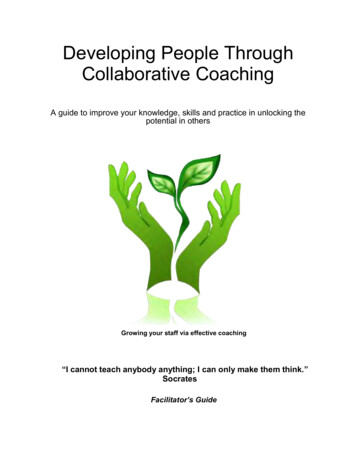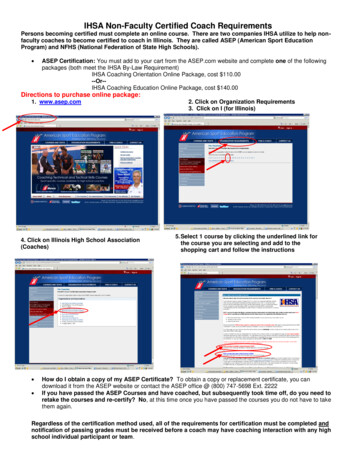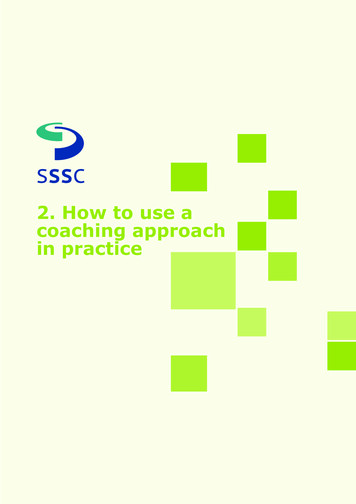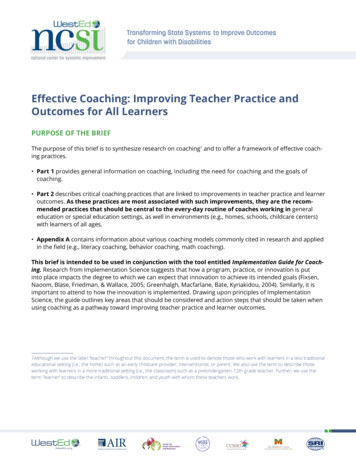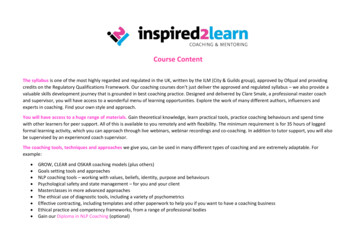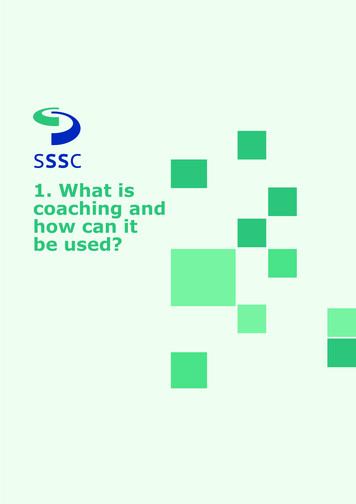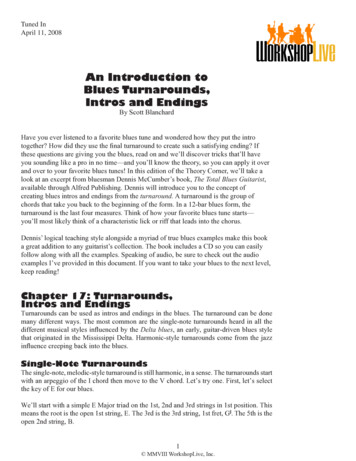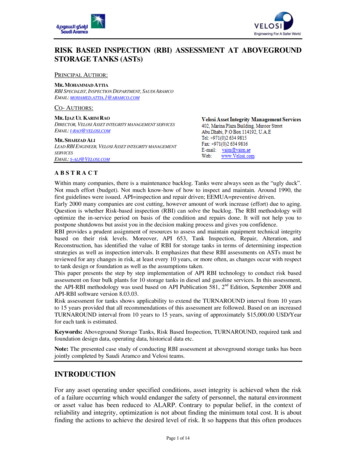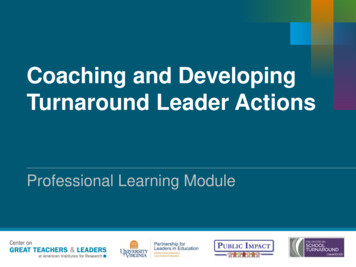
Transcription
Coaching and DevelopingTurnaround Leader ActionsProfessional Learning Module
Introductions, Agenda, andOutcomes2
Partner Organizations3
Introductions Your name Your role Your best ever development experience4
Agenda Introductions, Agenda, and Outcomes Connecting Turnaround Leader Actions and Competencies Assessing Leader Actions Coaching Turnaround Leaders Creating a Leadership Development Plan Closing Reflections and Next Steps5
Outcomes Understand the connection between turnaroundleader competencies and the actions of successfulturnaround principals and leadership teams. Learn strategies for coaching and developingturnaround leaders and supporting implementationof key turnaround leader actions.6
Rationale School turnarounds require strong leaders with thenecessary competencies to succeed. Turnarounds also call for leaders to take highleverage actions. Leaders need to know not onlywhich actions to take but also when and how to takethem within a given context. Coaching helps develop competencies and increasesthe application of knowledge and skills. Therefore,coaching is critically important in the development andsupport of turnaround leaders.7
Need for Principal DevelopmentWhat percentage of newprincipals are still at theirschool after 3 years?What percentage of fundingfor training programs goesto principal development?About half of new principalsleave their schoolswithin 3 years.Of the approximately 1 billionprovided annually to districtsfor training programs, only 9%of funds go toward supportingprincipals, whereas 91% isused for teachers.School Leaders Network. (2014). CHURN: The high cost of principal turnover. Retrieved from principal turnover cost.pdf8
Connecting TurnaroundLeader Actions andCompetencies9
Turnaround Logic ModelSchool-BasedPracticesConditions Great leader/competenciesGreat teachers/competenciesAutonomy: people,time, money,programsFundingSupport from state,district, and externalproviders Leader actionsTurnaround hool culture andclimateFamily IndicatorsAdult Behaviors Teacher retention Teacher attendance Teachereffectiveness Leader effectiveness SatisfactionStudent Behaviors Student retention Student attendance Graduation Advanced courses Satisfaction Enrollment Discipline incidentsAcademicAchievementOutcomesShort-Term Outcomes Midyear/interimachievementIntermediate Outcomes Achievement andgrowth on annualstate assessments College and careerreadinessLong-Term Outcomes College and careersuccessLutterloh, C., Cornier, J. P., & Hassel, B. C. (2016). Measuring School Turnaround Success. San Francisco, CA: WestEd.10
Turnaround Theory of ActionIF schools and districts hiregreat leaders and teacherswith turnaroundcompetencies and providethem with adequateautonomy, funding, andsupport; andIF they implement effectiveschool-based practices THEN leader and teachereffectiveness and studentengagement, behavior, andlearning will increase; andTHEN student achievement,graduation rates, andcollege and career successwill improve.Lutterloh, C., Cornier, J. P., & Hassel, B. C. (2016). Measuring School Turnaround Success. San Francisco, CA: WestEd.11
Turnaround Leader Competencies Competencies are underlying motives and habits—orpatterns of thinking, feeling, acting, and speaking—thatcause a person to be successful in a specific job or role. Competencies lead to actions that lead to outcomes. Competencies explain some of the differences inperformance levels of leaders. Competencies can be measured and intentionallydeveloped.(Spencer & Spencer, 1993; Steiner & Hassel, 2011)12
The Iceberg ModelQualifications: Certification DegreesKnowledge & Skills: Leader ActionsCompetencies: Recurring patterns ofthought and action Example:Achievement driveAdapted from “The Iceberg Model” in Spencer & Spencer, Competence at Work, p. 11.13
Turn and TalkThink about a strongturnaround leader and tellyour partner about thisperson: What makes himor her a strong leader?14
Turnaround Leader Competencies Achievement /Focus on SustainableResults Monitoring &Directiveness /Holding PeopleAccountable Initiative & Persistence Planning Ahead Self-Confidence /Commitment toStudent Learning Belief in LearningPotential Impact and Influence Team Leadership /Engaging the Team Developing OthersDriving forResultsInfluencingfor ResultsPersonalEffectivenessProblemSolving Analytical Thinking Conceptual Thinking(Kowal & Hassel, 2005; Spencer & Spencer, 1993; Zhu, Hitt, & Woodruff, 2015)15
Competencies Lead to Actions“Competency research suggests that outstandingperformance in complex jobs—ones in which mostcandidates have a similar educational history andsignificant autonomy over daily work tasks—isdriven more by underlying competencies than byreadily observed skills and knowledge.”(Steiner & Hassel, 2011, p. 5)16
Activity 1: ConnectCompetencies and ActionsWith a partner:1) Brainstorm and choose one action that a strongturnaround leader takes.2) Look at the list of competencies in your handouts anddiscuss which competency or competencies a leaderwould have to exhibit in order to consistently performthat action.17
Turnaround Leadership in ipsTeachers &LeadersChangeLeadershipCooper et al., in pressPublic Impact, 2015University of Virginia’s Partnership for Leaders in Education, n.d.18
Activity 2: Describe Turnaround LeaderActions Individually Each group member is assigned adifferent leader action ipsTeachers &LeadersChangeLeadershipCooper et al., in press Take 2–3 minutes to read thedescription and example for yourtopic in the handouts. Create a new example of this topicfrom your own experience. Prepare to present to your group:(1) explanation of topic; (2) example Group Each member takes 2 minutes topresent his or her leader action tothe group.19
Principal Supervisors:Providing Support and Accountability1. Diagnosing competency levels2. Setting leader development goals3. Facilitating leader development4. Frequently observing and providing feedback5. Monitoring and adjusting development plans6. Evaluating principal performance20
Assessing Leader Actions21
Tools for Assessment of Leader ActionsBehavioral EventInterviewMeasures candidates’strengths on thecompetencies as theydescribe past professionalevents in rich detail.Self-AssessmentAllows a school leaderto reflect on his or herpractice and evaluateperformance onleader actions andcompetencies.External ReviewUses staff, teacher, andleadership team interviewsto evaluate school leaderson each of leader actions.Turnaround Leader360 AssessmentProvides developmentalfeedback fromsupervisors, leadershipteam members, and staffon leader actions.Leader PerformanceEvaluationOutlines the standards,behaviors, andcompetenciesof school leaders.22
Behavioral Event Interview A behavioral event interview (BEI) is an in-depthway to measure candidates’ strength on thecompetencies. Past performance is an indicator of futureperformance. Prospective school leaders share stories aboutprevious work experiences that reveal theirleadership competencies. These stories lay thegroundwork for an analysis of how well leadersperform in a turnaround school. Although typically conducted during selection, theBEI can serve as a valuable development tool. For more on Behavioral Event Interviews, seeResources slide.23
Leader Actions Self-Assessment A self-assessment allows aschool leader to reflect onhis or her own practices andevaluate his or her ownperformance on turnaroundleader actions andcompetencies. For examples of turnaroundleader self-assessments,see Resources slide.24
Turnaround Leader 360 Assessment The 360 Assessment providesdevelopmental feedback on thedegree to which turnaround schoolleaders exhibit research-basedturnaround leader actions andcompetencies. Feedback is provided anonymouslyon a Likert scale and in narrative formfrom the leader’s supervisor, schoolleadership team members, staff andfaculty, and a self-assessment. For more on this resource, seeResources slide.25
External Review An external review can measure the extent to which turnaround principalsare engaging in the actions that research suggests are critical for success. These reviews may include conducting interviews and observations andproviding feedback that principals can use immediately to improve theirleadership capacity.26
Leader Performance Evaluation District performanceassessments outline thestandards and behaviors ofschool leaders. Some districts have includedturnaround leader competenciesand actions in performanceassessments of turnaroundleaders. For a sample that includesturnaround leader competenciesand actions, see Resourcesslide.27
Activity 3: Turnaround Leader ActionAssessment Simulation1. Individually Read transcripts on Principal Rosario and Ms. Roberts, taking noteson the following leader action types:– Vision– Goals2. Table groups Use the blank Turnaround Leader Action External Review to assessthe leader.3. Whole group How did you assess this leader? How would a tool like this be helpful in developing turnaround leaders? What would you add to the tool, or how would you change it?28
Coaching Turnaround Leaders29
Effective Professional omApplicationPresentation of Theory85%15%5–10%Modeling85%18%5–10%Practice and ng Components(Joyce & Showers, 2002)30
“I am altogether more confident andmore willing to stand up for my ideasand vision within my organizationbecause of coaching. I am also willing tobe more visible within the largercommunity, which is a big deal for me.”(CAP Action Guide for Coaches, p. 13)31
Coaching SkillsListen and paraphraseAsk powerful questionsProvide feedbackHold the leaderaccountableAdapted from Cognitive Coaching, 2015 Be present, listen for the essence, setaside judgment Acknowledge, clarify, summarize Ask questions that are open-ended,nonjudgmental, personal, andforward moving Ask permission, ground in data, keepbite-sized, align with goals andaction/competency development E-mail summary of actions, give anexercise to provide practice time, beginsession with reflection32
GROW Coaching CycleGoalIdentify thespecific andmeasurablechange that theleader wantsto make.RealityAssess thecurrent reality todetermine thegap betweencurrentperformanceand the goal.Whitmore, Coaching for Performance, 1992OptionsBrainstormpossiblestrategies forreaching thegoal.Way ForwardCommit tospecific actionsfor improvementand plan forfollow-up toassess progress.33
Activity 4: Coaching Simulation1. In small groups: Plan for coaching conversation using your external review and theGROW template2. In pairs: Round 1 Choose who will be the coach and who will be Principal Rosario. Role-play coaching conversation. Reflect on coaching conversation and give feedback. Round 2 Switch roles. Role-play coaching conversation. Reflect on coaching conversation and give feedback.3. Full group debrief34
CoachingExercises35
Activity 5: Card Sort Plus1. In small groups: Match each coaching exercise with a leader action. Identify additional coaching exercises.2. Full group debrief: Discuss matches that your group made. Share coaching exercises that you added.36
Creating a LeadershipDevelopment Plan37
Leadership Development Plan A leadership development and support plan should consist ofboth a plan for development and a plan to track progress.Development PlanTracking ProgressLeader GoalsLeader ActionsStrategies:- Coaching Actions- Coaching ActivitiesImplementation Targets:- Teacher/Adult Behaviors- Expected due to Leader ActionsLeader ActionsImpact Targets: Student OutcomesCoaching TimelineProgress Monitoring Routines38
Sample Development Plan39
Activity 6: Create a Development Plan1. Table groups Using Principal Rosario’s strengths and areas of growth from theexternal review and takeaways from your coaching conversation,create a development plan for Principal Rosario.2. Whole group What goals and coaching activities did you plan for PrincipalRosario? In what ways could you track Principal Rosario’s progress? How would using a plan like this be helpful? What challenges can you anticipate using a similar tool?40
Closing and Next Steps41
Wrap-Up: Reflection3-2-13 Ideas2 Questions1 Action42
Resources1. Behavioral Event Interviews– Hitt, D. (2015). “What it takes” for a turnaround: Principal competencies that matter for studentachievement. A guide to thoughtfully identifying and supporting school leaders. Center onSchool Turnaround at WestEd & University of Virginia Darden/Curry Partnership for Leaders inEducation. San Francisco, CA: WestEd. Retrieved �� Public Impact. (2008). Turnaround Leader Selection Toolkit. Retrieved round Leader Selection Toolkit.pdf2. Leader Self-Assessment– Public Impact. (2015). Self Assessment: School Turnaround Leader Actions. Retrieved /2016/02/Turnaround Leader Actions Self-Assessment-Public Impact.docx– Public Impact. (2015). Self Assessment: School Turnaround Leader Competencies. Retrievedfrom 6/02/Turnaround Leader Competency Self-Assessment-Public Impact.docx43
Resources, continued3. Turnaround Leader 360 Feedback Assessment–ESC 13 and Public Impact. (2016). Turnaround Leader 360 Feedback Assessment. Retrievedfrom http://turnaround360.net/4. Leader Performance Evaluation– Florida Department of Education. (2012). Observation and Evaluation Forms and Proceduresfor Leadership Practice. Retrieved rlt/0071810-fslest.pdf44
ReferencesCenter on School Turnaround. (forthcoming). Turnaround theory in action. San Francisco, CA: WestEd.Coaching and Philanthropy Project. (2010). An action guide for coaches. Oakland, CA: CompassPointNonprofit Services. Retrieved from http://btw.informingchange.com/uploads/2010/03/CAP ActionGuide-for-Coaches1.pdfCooper, Cornier, Dean, Hitt, Kutas, Losoponkul, Lutterloh, and Meyers. (in press). Leading successfulschool turnarounds: Examples of actions taken by turnaround principals. Center on SchoolTurnaround. San Francisco, CA: West Ed.Costa, A., & Garmston, R. (2015). Cognitive coaching: Developing self-directed leaders and learners.Lanham, MD: Rowman & Littlefield.Hitt, D. H. (2015). “What it takes” for a turnaround: Principal competencies that matter for studentachievement. A guide to thoughtfully identifying and supporting school leaders. San Francisco, CA:WestEd. Retrieved from oads/2016/01/CenteronSchoolTurnaround What It Takes.pdfJoyce, B., & Showers, B. (2002). Designing training and peer coaching: Our needs for learning.Retrieved from arch/randd-engaged-joyce.pdf45
References, continuedKowal, J. M., & Hassel, E. A. (2005). Turnarounds with new leaders and staff: School restructuringoptions under No Child Left Behind: What works when? Washington, DC: The Center forComprehensive School Reform and Improvement.Lutterloh, C., Cornier, J. P., & Hassel, B. C. (2016). Measuring school turnaround success.San Francisco, CA: WestEd. Retrieved from ads/2016/04/CenteronSchoolTurnaround PublicImpact.pdfPublic Impact. (2015). School turnaround leader actions. Chapel Hill, NC: Author. Retrieved /2015/05/Turnaround Leader ActionsPublic Impact.pdfSchool Leaders Network. (2014). CHURN: The high cost of principal turnover. Retrieved les/principal turnover cost.pdfSpencer, L. M., & Spencer, S. M. (1993). Competence at work: Models for superior performance. NewYork, NY: John Wiley and Sons.46
References, continuedSteiner, L., & Hassel, E. A. (2011). Using competencies to improve school turnaround principal success.Charlottesville, VA: University of Virginia Darden/Curry Partnership for Leaders in Education.Retrieved from n Web/Content/Faculty Research/Research Centers and Initiatives/Darden Curry PLE/School rnaround.pdfUniversity of Virginia’s Partnership for Leaders in Education. (n.d.). Leader competencies and turnaroundactions shown to influence student achievement. Charlottesville, VA: Author. Retrieved arden Web/Pages/Faculty Research/Research Centers and Initiatives/Darden Curry PLE/School 20and%20Actions.pdfWhitmore, J. (1992). Coaching for performance: GROWing human potential and purpose. London, UK:Author.Zhu, G., Hitt, D. H., & Woodruff, D. (2015). Identifying and validating a model for school turnaround.Manuscript submitted for publication.47
Partner OrganizationsFor more information on the Partner Organizations:Center on Great Teachers and Leadershttp://www.gtlcenter.org/Center on School ic Impacthttp://publicimpact.com/Darden/Curry Partnership for Leaders in ry-ple/48
Presenter com/xxxxxhttps://twitter.com/xxxxx49
turnaround leader actions and competencies. Feedback is provided anonymously on a Likert scale and in narrative form from the leader’s supervisor, school leadership team members, staff and faculty, and a self -assessment. For more on this resource, see Resources sli

